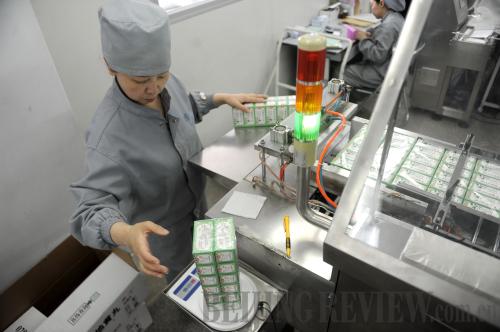|
 |
|
MODERN INDUSTRY: An employee of Lanzhou Foci Pharmaceutical Joint Stock Co. Ltd. packages TCM products (NIE JIANJIANG) |
The Institute of Medicinal Plant Development said their research could help solve the biggest problem hindering TCM industry's sustainable development: a lack of scientific theories involving medicine.
"While we retain and carry forward the TCM, it is necessary to press ahead with research and modernize the industry," said Chen Kaixian, a member of the New Drug Research Committee of Experts under the Chinese Academy of Sciences. "That is key to revitalizing the TCM industry."
Chen added that his research field is computer-aided medicine molecular design. and the purpose is to clarify and catalogue the molecule structure of TCMs.
A report from the CIConsulting said the most pressing job is to accelerate standardization, ensure product safety and strengthen supervision over the TCMs. Moreover, standards of international mainstay markets require TCMs be made in small dosages to facilitate storage, said the report.
In the domestic markets many foreign-produced TCMs are available. Developed countries like Japan, South Korea and the United States have massively collected TCM prescriptions and scrambled to apply for patents after changing their dosage forms and additives. So it seems that TCM standardization is not a mission impossible. Chinese TCM researchers and producers need to double their efforts to enhance standardization and modernize every link of the industry including theory research.
Liu Baoyan, CACMS Vice President, said the TCM industry has a rocky foundation and has yet to come up with an adequate quality control standard. This has put Chinese manufacturers in a weak position against international competitors.
In November 2010, the CACMS led more than 20 research institutions and enterprises to establish the International Medicine Alliance, aiming to put in place a set of standards for the industry.
But Fu Jinghua, a researcher with the CACMS, said China should not rely on a few enterprises to accomplish standardization, and the government should play a bigger role in the task.
Opportunities
Government measures to stimulate the TCM industry are already in the pipeline. In 2006, the Chinese Government mapped out a long-term blueprint for the sector's development until 2020, which attached great importance to theoretical research and innovation. In May 2009, the State Council announced a series of favorable policies for the sector, including heavier investments in TCM techniques, strengthened TCM services at community clinics, as well as professional training and resource protections. In addition, policymakers also vowed tightened efforts to safeguard the intellectual property right of TCM products.
In recent years China has proceeded with a sweeping medical reform across the country. The reform would shore up TCM enterprises and research institutions and pave the way for TCMs to establish an international market foothold.
Meanwhile, healthcare TCM products are also experiencing a surge in demands. In 2010, China reported more than 50 billion yuan ($7.7 billion) in sales revenues of healthcare TCM products, and the market is still growing by 13-15 percent year on year.
Anti-infection TCMs, in particular, enjoy a potential market, due to frequent epidemic explosions, said Guo Fanli, a pharmaceutical industry analyst with CIConsulting. In the national fights against the severe acute respiratory syndrome (SARS) in 2003 and the A/H1N1 flu in 2009, TCMs played an important role.
Healing woes
Domestically, concerns are growing that significant changes may happen to TCMs as the industry tries to adapt to modern standards. Fu Jinghua said the industry may go down the wrong path if it completely adopts the market entrance standard of Western medicine.
Most companies make TCMs in compound prescriptions and are therefore less likely to identify their chemical structures and components, he said.
Luo Xiwen, a researcher with the Institute of Philosophy under the Chinese Academy of Social Sciences, said TCM was China's only medical science before Western medicine made its way into the country. At that time China had never experienced any epidemic like that in Europe that killed millions in the Middle Ages (476-1453).
Zhang Qicheng, President of the Management College at the Beijing University of Chinese Medicine, said TCMs stand out with irreplaceable core competitiveness, as demonstrated by experiences with SARS and A/H1N1 flu.
"If we regulate the industry in line with Western standards and require TCM producers to release their prescriptions, it will lead to leaks of secret recipes and deal a deadly blow to the industry," said Zhang.
Liu Jianxun, a researcher with the CACMS, said TCM and its Western counterpart have their respective advantages. While TCM excels in curing bone, gynecological skin illnesses and chronic diseases, Western medicine is far more effective for anatomical, obstetrics and acute diseases, he said.
"Moreover, TCMs are more suitable for patients who are allergic or resistant to Western medicine. That is why we cannot measure TCMs along the same standard as Western medicine," said Liu.
TCM Industrial Overview
The TCM industry generated an output value of 317.2 billion yuan ($48.8 billion) in 2010, soaring 29.5 percent from a year ago. Total profit stood at nearly 30 billion yuan ($4.6 billion), up 33 percent year on year.
In 2010, there were more than 2,300 TCM manufacturers in China, employing nearly 500,000 people. The fixed asset investment in the sector totaled nearly 50 billion yuan ($7.7 billion), an increase of 16 percent.
China exported $1.94 billion worth of TCM, up 22.78 percent from the previous year.
(Source: National Development and Reform Commission) | 